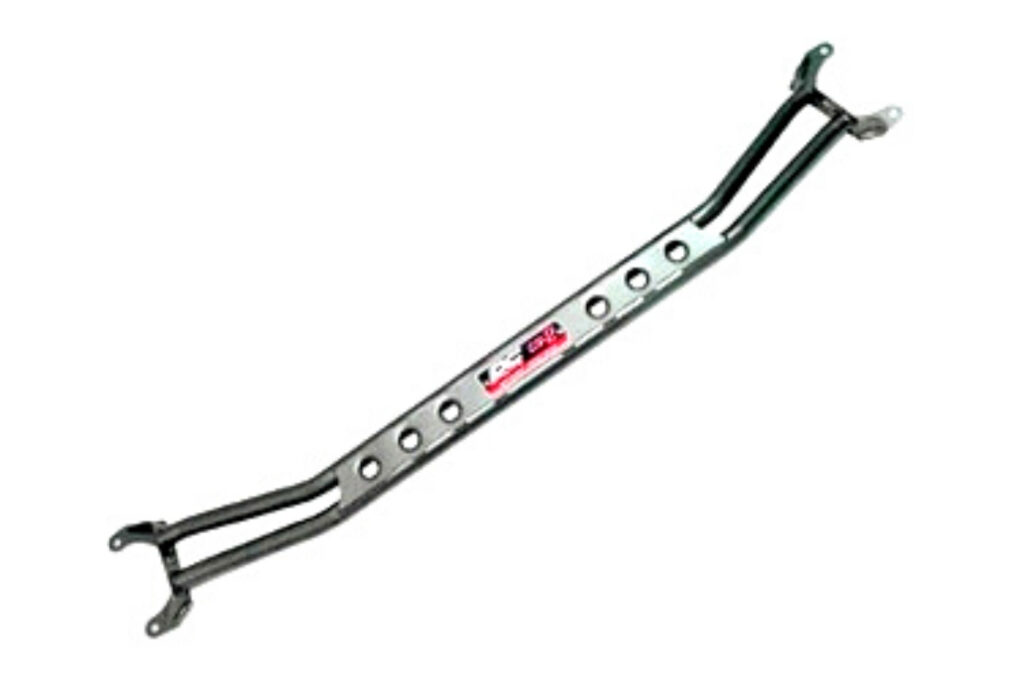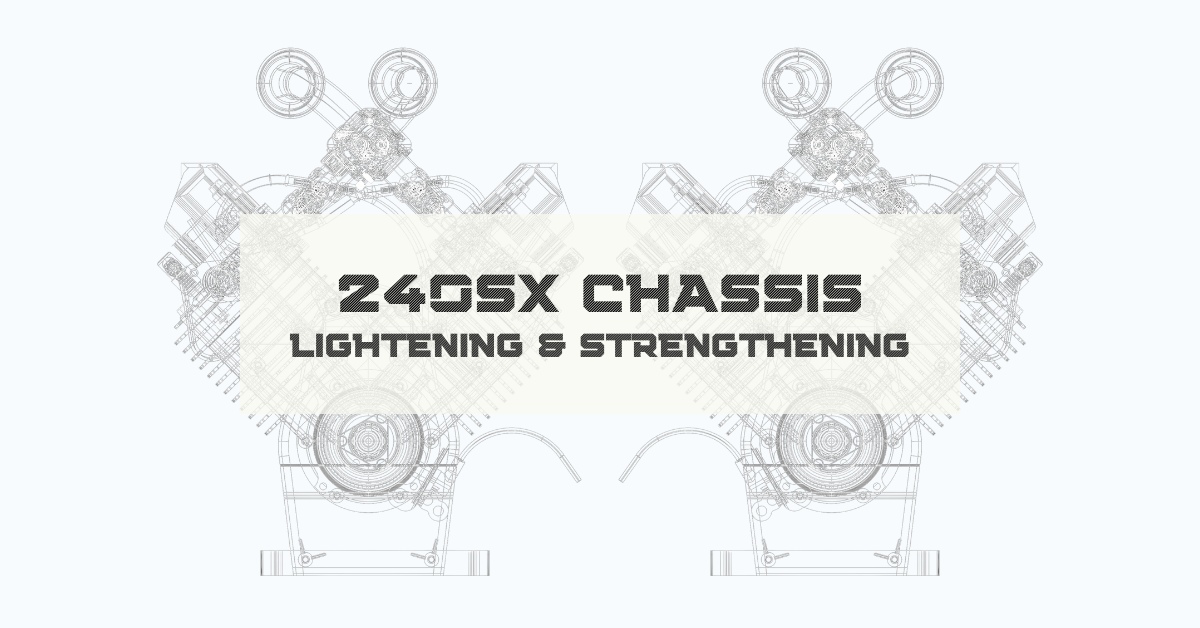Substantial handling improvements can be made to the 240SX by lightening and strengthening the chassis.
240SX Chassis Lightening
You can reduce the weight of the car by removing unnecessary parts and replacing heavy components with lighter aftermarket parts.
The following is a list of parts that you may consider removing and their weights:
| Sound deadening material: | 39.8 lbs. |
|---|---|
| A/C system: | 29.2 lbs. |
| Spare tire: | 28.0 lbs. |
| Hatch cover, speaker panels, and rear floor mats: | 23.8 lbs. |
| HICAS system: | 22.4 lbs. |
| Back seats: | 20.8 lbs. |
| Automatic seat belts: | 20.0 lbs. |
| ABS system: | 19.0 lbs. |
| Stereo and speakers: | 16.8 lbs. |
| Carpeting: | 11.8 lbs. |
| Jack tools and jack cover: | 6.4 lbs. |
| Total: | 238.0 lbs. |
The following is a list of parts that you can replace with lighter aftermarket components to save weight:
| Product | Possible Replacement Parts | Price |
|---|---|---|
| Front seats | Bride ZETA III Seat Sparco Speed Seat | $800 |
| Battery | Buddy Club Racing Spec Battery Braille Racing Battery | $150 |
| Hood | Seibon OEM Style Carbon Fiber Hood (S13) VIS Invader Type 6 Carbon Fiber Hood (1995-96 240SX) | $520 |
240SX Chassis Strengthening
Increasing 240SX chassis rigidity is critical for building a good handling car. If the car flexes, suspension geometry changes. Therefore, even if you have a great suspension setup on your car, it will be ruined by inconsistent flexing of the chassis.
The weak points in the 240SX chassis are around the firewall area and the rear hatch area in the S13 fastback. It is easy to get carried away with adding all sorts of stiffening bars and braces. However, many of these parts make very little difference and only add additional weight to your car.

Below, I list some 240SX body kit components that noticeably improve steering response and overall handling. If you want to stiffen the chassis as much as possible, the best option is stitch welding the frame lines and installing a roll cage. This should only be necessary for a high-horsepower car or one that you plan to race on the track often.
| Product | Effect | Price |
|---|---|---|
| SPL Front Fender Brace | Reduces flex in the firewall area | $260 |
| NISMO Power Brace | Stiffens lower front of chassis | $190 |
| Okuyama Type-I Aluminum Front Strut Bar | Stiffens front of chassis | $210 |
| DC Sports Rear Carbon Steel Strut Bar | Stiffens rear of chassis | $165 |
When it comes to maximizing the performance of your 240SX, reinforcing the chassis is a crucial step that should not be overlooked. Several modifications can be made to strengthen the foundation of your vehicle, ensuring it performs at its peak.
- Strut Bars: Designed to enhance the rigidity of monocoque or unibody chassis designs, strut bars are particularly beneficial for cars equipped with a MacPherson strut system. By preventing chassis flex and torsion, these bars stabilize the chassis and enable it to withstand higher G-forces. The result? A significant improvement over the factory suspension, providing superior performance and handling.
- Fender Braces: By establishing a robust connection between the bulkhead and the area beyond the firewall, fender braces contribute to overall chassis rigidity. With increased stiffness in the front end, you’ll experience enhanced steering response and improved turn-in. However, it’s worth noting that some reports suggest Fender braces may introduce a slight understeer tendency.
- Tension Rod Braces: The mounts for tension rods often exhibit significant flex, impacting performance. Reinforcing this area yields noticeable results. Upgrading with options like the Nismo power brace, which replaces mounts with welded bar and plate reinforcements, or adjustable bars like the Powertrix tension rod brace, enhances performance. Brands like Tanabe, Cusco, and Nismo also offer T/c rod brace solutions. While there’s some debate regarding oversteer or understeer tendencies, an adjustable bar can provide valuable fine-tuning options.
- C-Pillar Bars: S13 hatchbacks, especially the Zenki (’89-’90) and Chuki (’91-’94) models, often exhibit flex in the c-pillar area due to their rear openings. Bolting a C-pillar reinforcement bar to the rear seatbelt mounts can effectively address this issue. For an economically feasible option, a solid metal bar can be custom-made based on measurements between the two points, with mounting holes drilled accordingly. It’s important to note that coupes typically do not require this modification, as the c-pillar area is not a weak point for them.
- Lower Rear Tie Bar: Connecting the rear lower control arm to the centre of the rear sub-frame, the lower rear tie bar contributes to chassis stiffness. While its impact is relatively minor, it is often considered more of a cosmetic addition than a functional performance upgrade. As such, it’s recommended to prioritize other modifications before considering the lower rear tie bar.
Strengthening the chassis of your 240SX is a vital step in unlocking its full potential. By incorporating these modifications, you’ll experience improved stability, enhanced handling, and increased performance. Prepare to unleash the true power of your 240SX as you carve through corners with confidence and precision.
